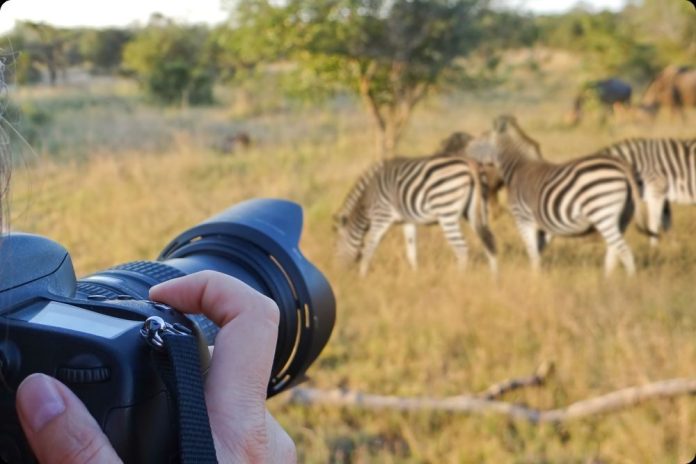Introduction:
South Africa is a photographer’s paradise, boasting a diverse landscape, rich biodiversity, and stunning wildlife. From the rugged coastline to the expansive savannas, each corner of this beautiful country offers unique photographic opportunities. Embarking on a photographic safari here promises not only breathtaking images but also unforgettable experiences. Let’s delve into the 10 best spots for photographic safaris in South Africa.
1. Kruger National Park
Kruger National Park stands as one of Africa’s largest game reserves, covering an area of nearly 20,000 square kilometers. Home to the iconic Big Five (lion, leopard, elephant, buffalo, and rhinoceros), Kruger offers unparalleled wildlife photography opportunities. The park’s extensive road network provides access to diverse habitats, ensuring encounters with a variety of species. From intimate close-ups to sweeping landscapes, Kruger presents endless possibilities for capturing nature’s beauty.
2. Sabi Sand Game Reserve:
Adjacent to Kruger National Park, Sabi Sand Game Reserve is renowned for its luxury lodges and exceptional game viewing. What sets Sabi Sand apart is its intimate safari experience, allowing photographers to get up close to wildlife in their natural habitat. The reserve’s private concessions offer exclusive access, enhancing the chances of capturing rare and elusive species. Sabi Sand’s expert guides and trackers further elevate the photographic safari, ensuring unforgettable encounters with Africa’s wildlife.
3. Madikwe Game Reserve:
Nestled in the North West Province, Madikwe Game Reserve stands as one of South Africa’s hidden gems. As a malaria-free reserve, Madikwe offers a family-friendly safari experience without compromising on wildlife sightings. Photographers can expect to encounter a diverse range of species, including the endangered African wild dog and cheetah. The reserve’s varied landscapes, from open plains to rocky outcrops, provide endless inspiration for striking compositions.
4. Phinda Private Game Reserve:
Situated in KwaZulu-Natal, Phinda Private Game Reserve is celebrated for its conservation efforts and diverse ecosystems. Spanning over 28,000 hectares, Phinda offers a mosaic of habitats, including savanna, forest, and wetland. This ecological diversity translates into exceptional photographic opportunities, from birdwatching to capturing the drama of predator-prey interactions. With its exclusive lodges and knowledgeable guides, Phinda promises an immersive safari experience tailored to photographers’ needs.
5. Kgalagadi Transfrontier Park:
Bordering South Africa, Botswana, and Namibia, Kgalagadi Transfrontier Park is a vast wilderness characterized by red sand dunes and sparse vegetation. What sets Kgalagadi apart is its unique desert landscape and resident predators, such as the iconic Kalahari lions and elusive leopards. Photographers visiting Kgalagadi can capture the stark beauty of the desert against dramatic sunsets and starry skies. Patience and perseverance are rewarded with intimate glimpses into the lives of Kalahari’s inhabitants.
6. Addo Elephant National Park:
Located in the Eastern Cape, Addo Elephant National Park is synonymous with elephant conservation and offers exceptional elephant viewing opportunities. Beyond elephants, the park is home to buffalo, lion, and a variety of antelope species. Addo’s landscape, characterized by dense thickets and open grasslands, provides a picturesque backdrop for wildlife photography. Photographers can embark on self-drive safaris or guided tours to explore the park’s diverse habitats and photographic hotspots.
7. Hluhluwe-iMfolozi Park:
As one of Africa’s oldest game reserves, Hluhluwe-iMfolozi Park holds historical significance and ecological importance. Situated in KwaZulu-Natal, the park is renowned for its efforts in rhinoceros conservation, particularly the endangered black rhino. Photographers visiting Hluhluwe-iMfolozi can capture intimate portraits of wildlife against the backdrop of rolling hills and meandering rivers. The park’s extensive road network ensures memorable encounters with Africa’s iconic fauna and flora.
8. Pilanesberg National Park:
Conveniently located near Johannesburg and Pretoria, Pilanesberg National Park offers a convenient escape into the wilderness. The park’s volcanic landscape, dotted with ancient craters and rocky outcrops, provides a striking setting for wildlife photography. Pilanesberg is home to a diverse array of species, including the Big Five and rare antelope such as sable and tsessebe. With its network of hides and viewpoints, photographers can capture intimate moments while immersing themselves in nature.
9. Marakele National Park:
Tucked away in the Waterberg Mountains, Marakele National Park is a sanctuary for both wildlife and photographers alike. The park’s rugged terrain, punctuated by towering cliffs and deep valleys, offers dramatic landscapes and breathtaking vistas. Marakele’s diverse habitats support a variety of species, from mountain zebras to elusive leopards. Photographers can explore the park’s winding trails and hidden waterholes, unveiling moments of raw beauty in the heart of South Africa.
10. Table Mountain National Park:
While not a traditional safari destination, Table Mountain National Park in Cape Town offers unique photographic opportunities. The park’s iconic Table Mountain provides a stunning backdrop for capturing the cityscape and coastal scenery. Nature enthusiasts can explore the park’s diverse ecosystems, from fynbos-covered slopes to pristine beaches. Table Mountain National Park serves as a reminder of South Africa’s natural splendor and the intersection of wilderness and urban landscapes.
Conclusion:
South Africa’s natural beauty and rich biodiversity make it a top destination for photographic safaris. From the vast plains of Kruger to the desert landscapes of Kgalagadi, each location offers its own charm and photographic allure. Whether capturing intimate wildlife portraits or sweeping panoramas, photographers will find endless inspiration in South Africa’s untamed wilderness. Embarking on a photographic safari here is not just about capturing images but about experiencing the magic of Africa’s wild places.

















